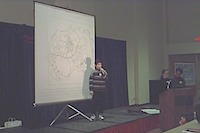The philosophy of the GTP was based on a humanistic-constructivist model of teaching. In the research link, you can read detailed papers on this. Here (Figure 1) we simplify by contrasting the traditional model of teaching with the model of teaching advocated and put into practice in the Global Thinking Project. Figure 2 summarizes our thinking about how learning takes place, and the model was used to develop the curriculum projects.
Figure 1. Global Thinking Contrasted with a Traditional Model of Thinking
|
The Traditional Model |
The Global Thinking Model |
• Traditional, mechanized thinking • Individualistic—although students may at times work together in groups, interdependence typically is not a goal. • Dependence—teacher-directed instructional model establishes a dependent social system. • Hierarchical—choice made for you; rarely do students choose content or methodology for their investigations. • Literacy—the emphasis is on knowing facts, skills, and concepts. • Content—the emphasis is on acquiring the right body of knowledge. • Learning encourages recall, and is analytical and linear. |
• Innovative, flexible thinking • Cooperative—students work collaboratively in small teams to think and take action together. • Interdependence—a synergic system is established in groups within a classroom, and within global communities of practice. • Right to choose—students are involved in making choices including problem and topic selection, as well as solutions; reflects the action processes of grassroots organizations. • Literacy—this is a new literacy insofar as "knowledge" relates to human needs, the needs of the environment, and the social needs of the Earth's population and other living species. • Content—the emphasis is on anticipation and participation, inquiry, learning how to learn, and how to ask questions. • Learning encourages creative thinking, and is holistic and intuitive. |
Figure 2. Global Thinking Learning Cycle


